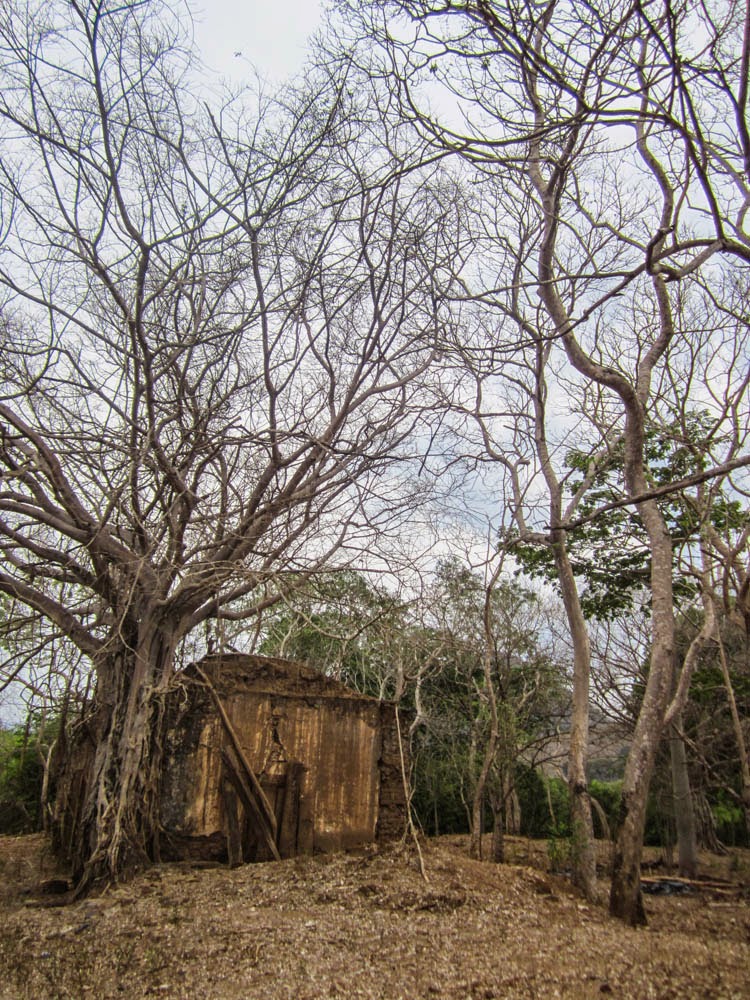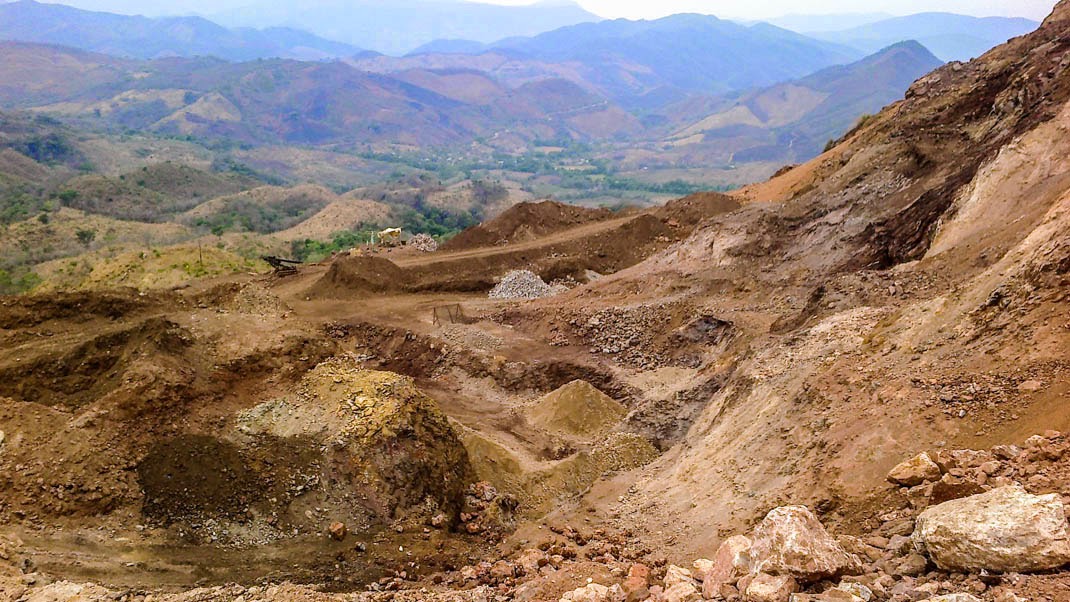By: Valentina Valle
May 20, 2014
These places are beautiful and rich in history, but when visiting them, the atmosphere we breathe is ghostly and the feeling of restlessness is constant. Hihuitlán, in the municipality of Chinicuila, is the last village where there are roadblocks of the autodefensas: from then on, it remains “no man’s land”. A farmer returning from the corn fields with his bundle of corn on horseback comes over and asks us what we came here for and where we are going. Shortly ahead, near the palapa erected by the autodefensas is the last of the first roadblocks of Michoacán. A massive block is still blocking the road and a man is still sitting in front of a cabin. To the right of him are pieces of what was a hacienda, trees have grown in the adobe walls. The air is still; time has stopped. Now, like ten years ago, the community watch the village, they question us, their request is not a nuisance but a guarantee of safety.
Almost nothing is known about the history of these people who in the beginning of the 2000’s, faced the narcos who came down from the mountain of La Morena, a place still infested with criminals. Once again it was the women who lead the resistance that has unfortunately been lost in the memory of others. Back then there were no AK-47’s or rifles, the only weapons they had were the weapons they used to protect livestock , and even then they didn’t arms themselves until after the assassination of Vicente Virgen Cerillos, father of the mayor of Chinicuila and a brave man who defied the cartels. Compared to the media noise that erupted in the last 16 months, after the armed uprising of Tierra Caliente, the struggle of this corner of Michoacán went completely unnoticed. Maybe it was because of the lack of heavy weapons or because it was a rebellion on common land where there were no lemon or avocado orchards, or even ranchers; but there was not a word devoted to these farmers who with sticks and rocks blocked the roads and managed to remove the traffickers. Or maybe it was because it seemed that there was nothing on this land but oil, and to exploit hydrocarbons it is not only desirable but almost necessary that the land in which this precious liquid is needs to be as empty as possible. Whatever the reason, the inhabitants of the common land of Barranca Seca were left alone and if on one hand they managed to remove the Milenio Cartel and the Zetas, on the other hand they couldn’t stop the advancement of the Templarios. The result is where ten years ago there used to be a movement, resistance, and life, today, there are only ghosts.
 |
| Hihuitlán:what remains ofthe hacienda |
Pantla is in the municipality of Coalcomán and appears on our right after a half hour from Hihuitlán. 47 deserted houses greeted us in a tumbalsilence, just a dog barking behind a rusty fence. Here, there are only two houses that are inhabited, there are neither women nor children, no noise can be heard; there are only two men who are unloading a cart of firewood. A father and son answered quickly, looking elsewhere, they say that they stayed in the village even though everyone else had all left and they were always “at ease”. It is unclear what is at ease about living alone in a village abandoned by government oversight and at the fury of the narcos, what is clear though is that they don’t want to talk anymore.
 |
An abandoned house headingtowardsPantla |
El Guayabo, the second ghost town, is another half-hour away, coasting along burned cornfields and dried fields of grass. The houses on both sides of the single street look empty, broken windows, even the ones that have clothes hanging in the yard are lonely and dark. Two people become aware of our presence, a man sitting in the plaza, alone, and a lady at the door of her house, not even passing the doorstep. The basketball court is abandoned, the school is closed.
 |
| Basketball courtfromGuayabo |
At about five hundred meters away is Ahuijuillito, the third village. We stopped, got out of our car, and took photos. A lady with a child appears out of nowhere and disappears out of nowhere; answering the only question we could ask her: out of the 25 houses in the village, only four are inhabited. The trees have invaded the gardens; one covers what was a child’s swing long ago. The door of the church is closed, but it doesn’t have a lock. We don’t force it open out of respect that it might be the only sacred place in the town that breathes desolation.
Mr. Jesús García Martínez gets up from his hammock as we arrive. He greets us happily upon having an unexpected visit and he says that he has been living alone with his dog for three years; him and three other families, two old men that live towards the end of the street and the residents that live two houses down from there. No one can drive a car, no one can contact the “outside world”; the only link is a man who every Monday at 9 in the morning passes by to sell tortillas. Ten years ago there were many people, Don Jesús recalls, but then everyone left, some to other places, some to “another world”. The Templarios arrived all the way here, with their indiscriminate massacres, to sow death where there were only farmers who planted corn.
 |
| Ahuijuillito |
If the entire state is considered a strategic territory, these hills extending between Michoacán, Jalisco, and Colima are even more so: the mineral wealth of the subsoil, the presence of the beautiful sangualica wood in the forest, the closeness of the Michoacán coast and the port of Manzanillo, the ability to easily move between the three neighboring states, make this part of the municipality of Coalcomán full of captivating payoffs for organized crime. It is also suspected that the killings that occurred here were not only confrontations between rival drug gangs, but they also served as a measure to empty the land of its inhabitants.
“When working in Puerta de la Mina, we removed bags of dead animals from our territory, dead fishes floated and even a child who lived along the banks of the river died, after an illness of which the origin was never clarified. I myself, as a child, had stains on my skin by bathing in these waters that were once pure and clean”, a man native of Tepamillo, Chinicuila recalls. He adds: “Now, after almost thirty years, nature is just beginning to recover to its original form, but we hear that they want to reactivate the work and start again with the pollution.” As we approached the mine, and asking about the communities around, it is found that the revival of La Minita (The Mine) is more than a rumor.
The residents of Guadalupe del Cobre, in a meeting convened by the Council for the Development of Coalcomán—an organization recently formed by citizens of the municipality who, independently from the autodefensas, are looking to reorganize the coalcomanensesociety— they denounced that since a few months ago, they had seen truckloads of soil and expressed their concern to know who was exploiting their territory.
A Look at Mining in Coalcomán
The publication of Panorama Minero del Estado de Michoacán, from July 2013, published by the Mexican Geological Service, reported that the history of mining in Coalcomán dates back to 1907, when the first foundry of iron and steel was established in Spanish America. Following an interruption of work due to the war of independence, in 1823 the government was forced to suspend the law that prohibited foreign equity to work the mines and—in the context of a dispute between the English and the Germans for the control of mining—they began to carry out mineral exploration to investigate the events in places such as El Cobre, El Tabaquito and La Guadalupe.
Since the 50’s of the 20th century, there were many companies that took advantage of the richness of the coalcomanensesoil: Minerales de Puebla, Minerales de Colima and Compañía Minera Peñoles among others. In July 1994, the unit suspended the operations due to exhaustion of metals and after 20 years, in mid-2006, Pacific Barite Corporation S.A. de C.V, located in Zimapán, Hidalgo, resumed the exploitation of barite in La Minita and the exploration of Tabaquito.
The source of this information, a 2013 thesis for the Graduate Program in Earth Sciences at the National Autonomous University of Mexico (UNAM), said that in recent years exploitation operations were performed intermittently. What they don’t say is that these works were performed by the Caballeros Templarios. This detail became known after the uprising of the autodefensas, which was achieved with the handing over of extorted properties to their rightful owners. In this case, the mine would correspond with Erick Marte Rivera Villanueva, a National Action Party (PAN) representative and founder of the Barite Pacific Corporation. Three weeks ago, after years of silence, the panista (PAN member) questioned Rafael García Zamora, municipal president of Coalcomán, about the alleged exploitation of their land by the comunitarios.
 |
| La Minita, Guadalupe del Cobre |
In La Minita, there is no evidence of the presence of this company or another. The sidewalks are kept free of trees or fallen branches and the rocky material looks freshly turned over. But the facilities look abandoned and the site looks deserted. However, there is a mining site located on the hillsides of the mountain, about ten minutes away, which doesn’t have a name or any indication of the owner but it’s still operating in full swing. Nothing indicates that the activity is carried out by Pacific Barite Corporation and the mine does not correspond to the images on the website of the company. The residents of Guadalupe del Cobre, however, say that there are no other mines and that all of this entire region, before being worked on by the Templarios, is being exploited again. Your question remains unanswered: Who is scratching the walls of Puerta de la Mina? Perhaps in this response, there is the first indication of the new powers that are trying to control the business interests of the region during this readjustment of this post-autodefensastate of Michoacán.
 |
| An unknown active mine in Guadalupe del Cobre |
Source:Sub Versiones
Additional photos:
 |
| The last of the first roadblocks |
 |
| A wall of the hacienda |
 |
| El Guayabo |
 |
| Truckclimbing the hill, Guadalupedel Cobre |










